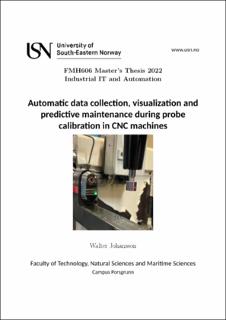Automatic data collection, visualization and predictive maintenance during probe calibration in CNC machines
Master thesis
Permanent lenke
https://hdl.handle.net/11250/3000366Utgivelsesdato
2022Metadata
Vis full innførselSammendrag
GKN Aerospace is a world leading supplier of engine parts in the aerospace industry, for both military and commercial engine programs. One of GKN’s 51 manufacturing locations is GKN Aerospace Norway AS (GAN), located in Kongsberg. GAN has numerous CNC machines that produces engine parts with strict tolerances. To measure parts and machine tools the CNC machines contain several measuring probes, needing frequent calibration. The visualization of the calibration data for analysis is a manual job that needs to be automated. Further, possibilities to utilize the calibration data for predictive maintenance would be useful for GAN. The objectives of the project is therefore to define a system for automatic collection and visualization of the calibration data, and to investigate possibilities regarding the use of Machine Learning (ML) to predict machine- or equipment health. In collaboration with GAN, a 5-axis vertical machining center (M5081) was chosen as the concept machine. A new log type with a uniform notation and setup was developed an tested on M5081. The system defined was tested locally with the same tools used in the CoPilot environment at GAN. CoPilot is GAN’s chosen application for monitoring, where the new functionality is thought implemented. Regarding predictive maintenance a Nonlinear Autoregressive Neural Network was trained to predict future values of a trigger constant. The resulting prediction was found insufficient for predicting time until the next machine stop. To investigate possible correlations between the calibration data and available temperatures in the machine, PCA was performed. Considering the correlations found here and the possible implementation of a spindle vibration sensor at GAN, it is concluded that a Nonlinear Autoregressive with External Input Neural Network should be tested with temperatures and spindle vibration as inputs, to possibly obtain better predictions.
